[Note: This article was written by Marion Rice. See the other articles in her Carfree Families column.]
My son is five (turning six in August) and has had his own “big boy bike” for about a year now. It mostly sits in the garage. He’s just not ready.
As much as I would like him to be, he just isn’t.
Every once in a while, I check in and see if he wants to ride around the block on his bike, and I walk/run along beside him. Even though he can ride by himself and gets a lot of positive reinforcement from his parents, it hasn’t been a very good experience. He gets frustrated easily, drops his bike, kicks it, declares he would like it if it were yellow and storms home.
“He gets frustrated easily, drops his bike, kicks it, declares he would like it if it were yellow and storms home.”
His expectations for riding his own bike seem to be out of whack: like I said, he’s just not ready. I am listening to him, not just what he says but what he does. Even though I can see the fun we will have biking around together as a family, him on his own bike, I will not let that lead me into pressuring him to be ready any faster.
Parents have asked me when is the right time for kids to be able to be independent on their bikes. The BTA’s Safe Routes to Schools director Angela Koch says children do not have the skills, mental development, physical development, or experience to handle traffic by themselves until they are 10 years old for the following reasons:
- They have not fully developed their motion sensitivity – they cannot accurately judge the distance or speed of moving cars.
- They have a narrow field of vision (about one-third narrower than adults), so they cannot see a wide area of the street without turning their heads.
- They are unable to pick out certain sounds and cannot judge accurately the direction of sound – they often turn their heads in the opposite direction of the moving vehicle they hear.
These all seem really reasonable to me, but there is a major difference between kids that are five and 10 years old and there are many stages between not wanting to ride a bike solo at all, and being able to ride in traffic.
For now we are happily riding around with my son on the Tag-a-Long bike.
How are you handling the long road to bike independence with your kids? What advice and inspiration can you share with us (aside from telling me to get a can of yellow paint)?


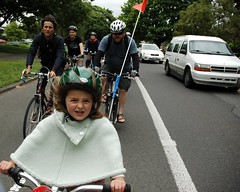
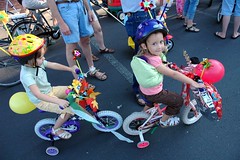
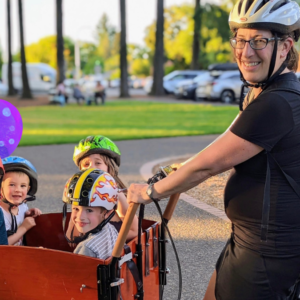
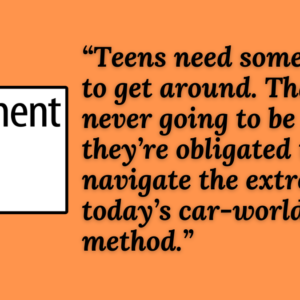
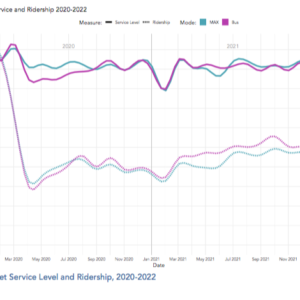

Thanks for reading.
BikePortland has served this community with independent community journalism since 2005. We rely on subscriptions from readers like you to survive. Your financial support is vital in keeping this valuable resource alive and well.
Please subscribe today to strengthen and expand our work.
They also sell yellow duct tape. 😉
Granted my children are in their early 20\’s. But the older child rode her bicycle, unsupervised to and from kindergarten (1/2 mile, entirely in a quiet neighborhood). Younger child didn\’t learn to ride w/o training wheels until he was 7, but then he also occasionally rode to/from school. Otherwise, they both walked (unaccompanied). By the time they were 10-12, they were riding up to the Cedar Hills Shopping Center, again, unsupervised. I just made sure they knew where they were going, and let them go. When younger child was in his teens, he had no issues riding on Walker Rd (the part w/o bike lanes). I\’d have preferred to not know that, but yet, he\’s made it to 21 with no bike-related injuries. Our goal was to raise independent people who would think for themselves. We didn\’t consciously have them cycle alone, but I both my husband and I grew up with that degree of independence and didn\’t see the need to restrict our children so much that way.
Of course, this means that sometimes they go off (especially when they get the driver\’s license) and you aren\’t entirely clear that the football game is in McMinnville, rather than at Sunset HS…
I biked to school with other kids from the neighborhood starting in 4th grade. I was 9 or 10 at the time. I also seem to recall biking around the neighborhood (NE Neighborhood streets) the two previous summers. We would bike to Wilshire Park and play on the playgrounds, swing, splash in the wading pool and make friendship bracelets- ah good times.
He is ready to Zoobomb! We drop and kick our bikes all the time.
Our five year old rides on the street with us riding to his left and telling him when he should stop and go. This is only on quiet streets. Any major intersections involve me walking him across with him riding to make sure he keeps going and everything is calm & safe. We\’re not afraid to wait a long time for a big gap in traffic. We often have to wave off drivers who try to \”help\” by yielding when they have right of way. This can result in cars going around the front car or cars coming from the opposite direction not stopping. It\’s a bugger because the driver is trying to be helpful and friendly but this is often the riskiest of all.
Zaphod @5 \”We often have to wave off drivers who try to \”help\” by yielding when they have right of way.\”
Man, you said a mouthful. That\’s my personal pet peeve. Selfish drivers are predictable. The \”helpful\” drivers — totally random.
Our oldest just turned four and his brother is two point five.
The older lad rides a Skuut with aplomb (he took second with it in his age group at the kids race during the Mt. Hood Classic prologue).
The kick bike has really helped his balance and I imagine we\’ll have the training wheels off his pedal bike by end of summer.
He can also do 10 miles with a smile on the trailabike. And we\’re working on an extracycle conversion for my wife as well. Our Burley double trailer is still in use for the younger and can hold both of them in a pinch.
That all said, both are well on their way to being a recreational cyclists. But vehicular cycling can wait until they are 10 or so. I agree with many of the observations in re this as noted above.
For us, variety has worked well. Positive feedback and watching dad ride to work most days probably helps. The kids\’ races at PIR are now a weekly commitment (but, hey, we live right up the hill, so it\’s fairly easy.) And both boys love spectating at any race held at Mt. Tabor.
Setting an example and exposing our boys to varied types of cycling has worked wonders in our household. (knock on double-butted Reynolds)
Your milage (and the color of your ride) may vary.
See you on the road and/or the track!
Peter (18 tomorrow, just missed the primary, sorry Sam), was not enthusiastic on his own for much distance, any hills or headwind until year before last. He was on a true tandem with me from 4 when he outgrew the trailer. He really helped when we needed the afterburner on hills. No slacking on a tandem, when I\’m spinning, he\’s spinning. I miss it, we really had a blast.
So, in two years he went from noodling around for a couple blocks to 20 miles per day to and from school a few times a week, lusting after an even lighter bike and maybe a cyclo-cross bike.
Be patient, adapt, get a tandem that you like to ride too. When he starts riding on his own, keep up to date with bikes that are fun for him to ride (good repair, light, right size), make it simple to like it.
Steve
Every kid is different, and much has to with the kid as with the family.
I have found that a very important thing for the kid is to be comfortable riding their bike. They need enough strength to be able to control the bike, and to kick it up to speed. A bike which is too big or heavy will be difficult for anyone, especially a child. The child also needs enough endurance to keep the speed high enough to keep control of the bike; slower moving bikes are harder to control. A strong and active kid will be able to do this more easily. And endurance is built over time.
Don\’t underestimate the destination as an incentive to ride. When practical, let your kid suggest or choose the destination. You may also wish to try bribes (incentives or rewards) when the destination itself would otherwise not be of interest to the child.
Start with short distances. Halfway down the block; then around the block; then to the local park/school/library/friends house/candy store, or something else that the kid wants to go to that is less than about 1.5km (aprox 1mi). Then go on to further and further destinations; stop often along the way, let the child explore and discover things along the way.
My daughters are 16 months apart. My eldest is turning 7 in just a few days, my youngest is five. They both learned to ride their own two wheelers about 2 years ago; this is their third year of riding without training wheels.
We often take rides of 40km (aprox 25mi) over the day, but we have done 60km (aprox 40mi) days. Lots of breaks are needed when we do these distances, as are destinations worth going to. For my own kids \”food\” and yummy \”treats\” are always good incentives (rewards) for these kinds of distances. But the promise of a new playground or other destinations, like the Museum, is a good incentive as well. Group rides, like Critical Mass, also excite and energize my kids; they love riding in big groups.
Our kids ride their own bikes on the busy streets of Toronto with us. I do my best to carefully choose routes that will be comfortable, but not enough of our roads have bike lanes. Most of our destinations are not on bike routes. Our girls are (slowly) learning how to ride in traffic by practicing with us. We\’ve all had to learn to adapt to riding in traffic, especially my wife who does not have as much experience, or chutzpah, as me. I also took the CAN-BIKE course to help my confidence, and then I became a CAN-BIKE instructor (the CAN-BIKE program is roughly equivalent to the Effective Cycling program). This really helped me to help all of us. I would suggest you find a program like this.
Last year we taught our daughters how to cross streetcar tracks. Now most of downtown is more comfortable to ride in than our own inner-suburb neighbourhood. That\’s because motor traffic speeds are much slower and there because there are lots of other cyclists downtown.
You\’ll find your own comfortable places to ride, and your own reasons for riding there. Just give it time, patience, practice, and lots of reasons to ride!
My 5 year old recently expressed interest in riding w/out training wheels.
Before we started, I let her know it\’s going to take a little work, and she most likely won\’t get it the first time.
She tried for a little while, but didn\’t get the hang of it, threw down the bike and got rather pissed at herself. I fixed that with some reassurance that we\’ll try again next week, and of course some ice cream.
I am now considering picking up one of those razor scooters so she can work on balance without the fear of falling, we\’ll see how that goes.
If you believe in the idea: \”It takes a village,\” that sure would help the kids in our community come into their own with biking. I love helping a kid I\’ve never met on his/her bike and seeing the parent be okay with it. Yeah for non-individualism!
My oldest daughter took an extra year to get used to her big bike. She started out fearless then had one tumble and that set her back. My youngest started out well but took her longer to develop her skills. It all seems to be related to when the child is ready and confident. Some seem motivated by the thrill of riding and others by the fear of not falling. As my kids have gotten older they have moved from the fear to the thrill of riding.
I have also found that my kids always learn better and try harder when I am not coaching them. Find a family friend or neighbor that is willing to coach them and I bet he/she will be more motivated and try harder to ride the big bike. It\’s hard when you are a parent who is interested in cycling and your kids are fighting it. You want to enjoy it with them. Have patience and before you know it they will be kicking your butt.
Hey, thanks EVERYONE for sharing your experiences and insights. I think there is so much good stuff here. I might get him a Razor.. good idea for balance etc. I think he would dig it.
Keep the great suggestions coming
Hi Marion,
I have two boys (8) and (5). My oldest has a well-developed physical intelligence and has been riding a 2-wheel bike since he was (4). Although I completely trust him on family rides, I don\’t trust drivers or his ability to gauge unpredictability. He must always ride between my wife and me or in front of us singly, and every outing is an opportunity for teaching. We take a lot of short neighborhood rides and to point out dangers and teach rider awareness. It works. We have even taken several family bike rides from N PDX to downtown through back streets, and he is always improving. We use the same techniques described above. We are doing the same with our youngest, but he is on the tag-a-long. Even when they\’re older, I will never be at ease, though. Who is, even by themselves! Good advice from everyone above and Angela Koch.
A good trick to teach little ones balance (better than a scooter) is to take the pedals off a normal bike. The seat should be low enough so they can flat foot on the pavement. Teach them to scoot and push themselves around. They\’ll \”get it\” very quickly, i.e. what it feels like to balance on a bike.
Good luck!
John
I agree with AMH – every kid is different. And so is every parent/child relationship, so keep that in mind, as well.
My oldest daughter, who\’s 9, rides with us when we\’re commuting to school or other events. We take her in traffic and we\’re constantly talking the whole time on why we\’re making the decisions we\’re making, what\’s going on around us, etc. I trust her that if I tell her sternly \’STOP\’ or \’take the lane behind me and follow close\’, or whatever – I know she\’ll do it.
Daughter number 2, however, may not be in traffic anytime soon. She\’s more inclined to demand why and do things her own way! She\’s not on her own bike yet for any great distance (still in a trailer for my daily commute through downtown or a tag-a-long on family rides) but I just know that she is a very different child therefore our relationship is quite different. Teaching her to ride with traffic on her own will likely be a slower, more painstaking experience but I have to honor that.
Regardless, the most important part of bike independence is the connection you\’re making with your kid during the whole process. I wouldn\’t have it any other way.
And, I have to add, that I find it especially important for my girls to be with their mama on a bike in traffic on a daily basis to reinforce their own confidence as young girls who I hope will be strong, fearless women someday. Just little shout out to the sisterhood! 🙂
I\’m loving these family posts/discussions! Thanks!
My daughter will be 6 in September and has been riding her own bike since last Fall. It\’s a tiny bike but that makes her the most comfortable. She can easily get her feet flat on the ground. The trade off is that she\’s working her tail off pedaling those tiny wheels.
As a family we\’re fairly new to biking (I hadn\’t been on a bike for many many years before last year).
What helped my daughter be more interested in riding her bike was to select fun destinations. There\’s a fun little sandwich & gelato shop (Tilly\’s) across from our library. We have to cross one busy street (which we walk) but other wise get a 1/2 mile ride around our neighborhood streets. Ice cream has proven to be a great incentive.
We\’ve recently decided to start biking as part of our commute (one or two days/week). That\’s in real traffic so she gets in the trailer with her 3 year old brother.
But as part of all that I made up a little path/game board type thing where we color in each quarter mile that we bike or walk instead of using the car. Periodically there\’s an ice cream cone on the path which means we\’ve earned a treat (my attempt at removing ice cream as an automatic treat whenever we go to the library – which is a weekly trip for us). There\’s a big family plan for the end of the path but that will take us a couple of months to accomplish and I knew that much delayed reward wouldn\’t work for my aged kids.
Last weekend she convinced us to bike to the grocery store because she wanted to color in squares. My son even convinced us to let him ride his trike (which worked for the ride there but I ended up walking both my bike and his trike home).
We\’ve also come up with specific words to use to communicate. \”Feet down\” means to not only stop but to really stop. She has issues staying right so we have specific words for when we\’re on a trail and riders/peds are oncoming or coming from the rear.
We\’ve only recently acquired a trail-a-bike and she hasn\’t used it. She might have been less inclined to switch to her own bike if she knew that was an option for bike rides. We got it for our son who is not at all happy to be sedentary in the trailer but he\’s too short to reach the pedals.
The Community Cycling Center in NE Portland has a wonderful bike camp for kids — my daughter went to their junior camp (ages 6-8) last summer, and learned to ride on the road with a group. The kids learned safety rules, learned about bikes and how they\’re put together, rode to parks, rode to playgrounds, and on the last day rode to a gelato shop.
Now she can ride to school and the neighborhood pool (accompanied by a parent) and she\’s becoming a more confident and skilled rider all the time.
Growing up, I never rode with my parents. I got my start –learning to ride a bike, using for my first transportation– with children from the neighborhood – most of them bigger and older than me. If I didn\’t ride my \”big kid bike\” I\’d have been left behind and I didn\’t want that.
Kids are a lot more cutthroat about things like that than adults are or can afford to be. Does he have children he can ride with?
My 5 year old grandson just learned to ride two wheels this past weekend. For the past couple of months his balance was improving on his scooter. His bike was still to big for him, I borrowed a neighbor\’s 12 inch bike, so his feet can touch the ground while he was sitting on the seat, this way if he fells he is going to fall he can put his feet on the ground. I told him to scoot on the bike just like his scooter without putting his feet on the pedals. Once he got the feeling that he is not going to fall, the next step was to use the pedals. He wabble a couple of times, fell, but he did not give up. He started to ride around the courtyard in circles. He then asked me o take off the training wheels from his bike. Each time he rode, the better he got. Through this whole process, I kept encouraging and cheering him on even when he fell, I told him, \”he did better than me at his age. This helps his confidence. These techniques came from the League of American Bicyclist Bike Ed program for children (slightly modified). Here are a few suggestions:
1) lower the seat so he can touch the ground while being seated. (If he is on tip-toes, borrow a smaller bike, he will only need for a day, until he learns to ride)
2) Scoot like he is on a scooter, until he feel confident to ride pedaling.
3) Pedal first in a straight line, then practice turning, then starting and stopping, after that let him ride as much as he wants (Practice, Practice, Practice.
4) Always Encourge, Praise and Cheer him on
When my child was 4-5 years old we used a trail bike and the trailer; trailer was for when she got to tried of riding.
We had to put clip peddlens on the trail bike because, the kids feet would not stay on the peddles. We even had clip peddles on the little Trek with training wheels.
The kid is 10 now; and for the 1st time today while watching the kid ride up the street to school I saw the kid stand up and peddle to get going, that made me smile the kids been working on this for weeks.
Jacob (#10), to follow up on John\’s (#14) method, what I did with my daughter was to take her to a gentle, grassy slope and had her just coast to the bottom with her feet off the pedals several times to get the balance part down. After that, I had her pedal the bike in a flat, grassy area. After that, she progressed to riding in circles on a nearby basketball court. The whole thing took less than an hour, and she rode the bike all the way back home on the sidewalk. I originally read about this method in Bicycling magazine, and I swear by it!
My daughter is now seven, and she just graduated up to a bike with 20\” wheels. At first, she was uneasy because she couldn\’t touch the ground while seated. I explained to her that I can\’t on my bike either, and that she just needs to hop off the seat as she comes to a stop. It took her about 15 minutes to get that concept down.
My wife and I have been riding around on the roads with our 5 year old son for a few months now. It has been one of the best times of my life.
My son took a while to learn to ride but now is very confident on and off the road. The things I believed helped
1. We did the trailer and trail-a-bike since he was 2.
2. He has a friend that he rides and with.
3. Patience.
4. Starting small. i.e. just ride on the road from one driveway to the next.
5. My favorite. \”its either we walk or ride.\” (he hates walking).
6. Persistance. We asked all the time and one day he said yes. We have not looked back.
7. Obsticale courses. We set up cones, sticks and boards on our sidewalk to maket the riding more fun, and to build skills.
We had some arguments and fits and yes, even yelling(god forgive me) and crying, but sometimes that is part of learning to get along with ourselves and others. But to me it has been very much worth it.
As far as teaching to ride we did the things mentioned in the other posts. It did not take him a day, but it worked well.
Forgot to add. So far without exception all the car drivers have been extremely nice and considerate of my son riding on the road. Even when he collapsed in the middle of a 4 way stop and got tangled in his bike.
Get a tall flag for their bike so the cars know they are there. Having kids yell thank you alot and ringing their bell is also really cute.
After teaching our own children to ride, my sister and I came up with a nifty little invention, Bike Buddy. Finally, a new way to teach kids to ride! I taught my son using it when he was just 4 and he learned so fast! We see parents make a few important mistakes when teaching their kids though…Some important things to remember when teaching kids to ride:
1. They have to be able to plant both feet firmly on the ground when they lose their balance. It looks like their bike is too small, but let them learn, then adjust the seat. Borrow a smaller bike if you don\’t have one.
2. Using a harness will remove your hands from the bike. They can\’t control their own bike (and balance) with someone holding onto it. It\’s like drinking from a cup that someone else is holding. The harness will save them from falling…which can actually make learning safer and fun!
Good Luck!
Rebecca
http://www.bike-buddy.com
I saw a tiny bike on Ebay for about 150 with drops and small wheels for kids, I want to say it was 26 inches to the seat, I don’t know why he measured that way. I wonder if thats the right bike for a kid. They are bound to jump off curves and other such things. The bike may not hold up well. Plus they don’t seem to need to shift gears either. When looking for a “first bike,” keep in mind that children learn fastest on bikes they feel safe on, which are usually the smaller sizes. Of course, how fast they learn also has to do with their personality, coordination and confidence.